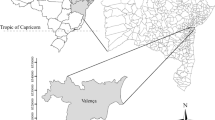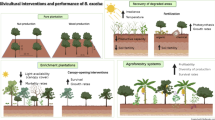Abstract
The density of neem trees in parts of Malindi District in eastern Kenya was assessed to determine the sustainability of their use in the local woodcarving industry. Size and age structure of neem populations under different ownership were analyzed to establish the Annual Allowable Cut. Neem is an excellent carving wood and the available quantities along the Kenyan coast are sufficient to sustainably supply the industry of the whole country. However, because the resource comes from small farm holdings and the supply system to carving groups is not well established, further efforts are required to introduce a management regime that could be certified under the standards of the Forest Stewardship Council.
Similar content being viewed by others
Literature Cited
Ad Hoc Panel of the Board on Science and Technology for International Development. 1992. Neem-a tree for solving global problems. National Academy Press, Washington, DC.
Ahmed, S., S. Bamofleh, and M. T. Munshi. 1989. Cultivation of Neem (Azadirachta-Indica, Meliaceae) in Saudi-Arabia. Economic Botany 43(1): 35–38.
Akhtar, M. 1998. Biological control of plant-parasitic nematodes by neem products in agricultural soil. Applied Soil Ecology 7(3):219–223.
Barbier, E. B. 2000. The economic linkages between rural poverty and land degradation: Some evidence from Africa. Agriculture Ecosystems and Environment 82(l–3):355–370.
Beentje, H. J. 1988. Atlas of the rare trees of Kenya. Utafiti 1(3):71–123.
Belsky, A. J., R. G. Amundson, J. M. Duxbury, S. J. Riha, A.R. Ali, and S. M. Mwonga. 1989. The effects of trees on their physical, chemical, and biological environments in a semi-arid savanna in Kenya. Journal of Applied Ecology 26:1005–1024.
Bennun, L., and P. Njoroge. 2000. Important bird areas in Kenya. Ostrich 71(1–2):164–167.
Blackett, H. L. 1994. Forest Inventory Report No. 4— Shimba Hills, Mkongani North and Mkongani West. Kenya Indigenous Forest Conservation Programme (KIFCON), Nairobi.
Braun, H. M. H. 1977. Seasonal and monthly rainfall probability tables for the East-Central, North-Western and Coast regions of Kenya. Ministry of Agriculture and Livestock Development, Nairobi, Misc. Paper M13.
—. 1986. Seasonal distribution of rainfall in Kenya. Kenya Soil Survey, Ministry of Agriculture and Livestock Development, Nairobi, Misc. Paper M14, revised edition, 10.
Brooks, T. M., S. L. Pimm, and J. O. Oyugi. 1999. Time lag between deforestation and bird extinction in tropical forest fragments. Conservation Biology 13(5):1140–1150.
Burgess, N. D., G. P. Clarke, and W. A. Rodgers. 1998. Coastal forests of eastern Africa: Status, endemism patterns and their potential causes. Biological Journal of the Linnean Society 64(3):337–367.
Camberlin, P., and O. Planchon. 1997. Coastal precipitation regimes in Kenya. Geografiska Annaler Series A—Physical Geography 79A(l–2):109–119.
Canova, L., and M. Fasola. 2000. Small rodents along a ground-cover gradient in coastal Kenya. Tropical Zoology 13(2):219–226.
Chapman, J. D., and F. White. 1970. The evergreen forests of Malawi. Commonwealth Forestry Bureau, Oxford.
Chibnik, M. 2000. The evolution of market niches in Oaxacan woodcarving. Ethnology 39(3):225–242.
Choge, S. K. 2000. Study of economic aspects of the woodcarving industry in Kenya: Implications for policy development to make the industry more sustainable. Master’s Thesis, University of Natal, Durban.
Dale, I. R. 1939. The woody vegetation of the Coast Province of Kenya. Imperial Forest Institute Paper 18:1–28. University of Oxford.
De Jong, C. 1977. Land utilization types of the medium potential areas of low altitude—the Kwale area. Miscellaneous Soil Paper No. 4, Kenya Soil Survey, Ministry of Agriculture, National Agricultural Laboratories, Nairobi.
Droppelmann, K. J., J. E. Ephrath, and P. R. Berliner. 2000. Tree/crop complementarity in an arid zone runoff agroforestry system in northern Kenya. Agroforestry Systems 50(1): 1–16.
Duffy, R. 2000. Tourism and African development: Change and challenge for tourism in Kenya. Journal of Modern African Studies 38(4):743–744.
Fitzgibbon, C. D., H. Mogaka, and J. H. Fanshawe. 1995. Subsistence hunting in Arabuko-Sokoke Forest, Kenya, and its effects on mammal populations. Conservation Biology 9(5): 1116–1126.
Frenken, G., B. Hornetz, R. Jaetzold, and W. Willems. 1993. Actual landuse advice in marginal areas of SE-Kenya by atmosphere-ocean-teleconnection. Tropenlandwirt 94:3–12.
Gillman, C. 1949. A vegetation type map of Tanganyika territory. Geographical Review 29:7–37.
Gladwin, C. H., A. M. Thomson, J. S. Peterson, and A. S. Anderson. 2001. Addressing food security in Africa via multiple livelihood strategies of women farmers. Food Policy 26(2):177–207.
Gordon, I. 2002. Personal communication, ICIPE August 2002, Nairobi.
Gravsholt, S., J. Jackson, and G. Ojo. 1967. Provisional tables for growth and yield of neem (Azadirachta indica) in Northern Nigeria. Research Paper, Savanna Forestry Research Station, Samara No. 1.
Jacobson, M. 1989. The neem tree. CRC Press, Inc., Boca Raton, FL.
Jätzold, R. and H. Schmidt. 1983. Farm management handbook of Kenya, vol. II/C, East Kenya. Erhart GmbH, Trier.
Kigomo, B. N., P. S. Savill, and S. R. Woodell. 1990. Forest composition and its regeneration dynamics—a case-study of semi-deciduous tropical forests in Kenya. African Journal of Ecology 28(3): 174–188.
—. 1991. The pattern and distribution ofBrachylaena huillensis in semi-deciduous dry forests in Kenya. African Journal of Ecology 29(4):275–288.
Kirubi, C., W. N. Wamicha, and J. K. Laichena. 2000. The effects of woodfuel consumption in the ASAL areas of Kenya: The case of Marsabit forest. African Journal of Ecology 38(l):47–52.
Leakey, R. R. B., J. Wilson, and J.D. Deans. 1999. Domestication of trees for agroforestry in drylands. Annals of Arid Zone 38(3–4):195–220.
Lewis, W. H., and M. P. F. Elvin-Lewis. 1983. Neem (Azadirachta indica) cultivated in Haiti. Economic Botany 37(l):69–70.
Lind, E. M., and M. E. S. Morrison. 1974. East African vegetation. Longman, London.
Luna, R. K. 1996. Plantation trees. International Book Distributors, Dehra Dun.
März, U. 1992. The economic potential of an agroforestry system with neem (Azadirachta indica A. Juss.) for small farms in the Sudano-Sahelian zone of Burkina Faso. Tropenlandwirt 93:23–38.
Maingi, D. R. 2001. A managment plan for neem as a carving wood in Malindi. People and Plants Programme, Nairobi.
Mathooko, J. M., and S. T. Kariuki. 2000. Disturbances and species distribution of the riparian vegetation of a Rift Valley stream. African Journal of Ecology 38(2):123–129.
Nanang, D., R. Day, and J. Amaligo. 1997. Growth and yield of neem (Azadirachta indica A. Juss.) plantations in Northern Ghana. Commonwealth Forestry Review 76(2): 103–106, 154–156.
Obunga, R., and G. Sigu. 1996. Sustainable development of the woodcarving industry in Kenya. Resource Assessment. National Museums of Kenya, Nairobi.
Pichi-Sermolli, R. E. G. 1957. Una carta geobotanica dell’Africa Orientale. Webbia 13(1):15–132.
Radwanski, S. A., and G. E. Wickens. 1981. Vegetative fallows and potential value of the neem tree (Azadirachta indica) in the tropics. Economic Botany 35(4):398–414.
Rembold, H., and E. Garcia. 1987. The azadirachtins —potent insect growth inhibitors. Proceedings of the International Symposium on Insect Physiology, Biochemistry and Control. Rio de Janeiro, Brazil, 10-13 November 1987. Memorias do Institute Oswaldo Cruz. 1987, 82: Suppl.III, 61–66.
Robertson, S. A., and W. R. Q. Luke. 1993. Kenya, coast forest status: Conservation and management. World Wide Fund for Nature and National Museums of Kenya, WWF Project No. 3256.
Schmidt, R. 1991. Ecology of a tropical lowland rain forest. Plant communities, soil characteristics and nutrient relation of the forests in the Shimba Hills National Reserve, Kenya. Diss. Bot. 179, J. Cramer Berlin, Stuttgart.
Schmutterer, H. 1988. Potential of azadirachtin-containing pesticides for integrated pest control in developing and industrialized countries. Journal of Insect Physiology 34(7):713–719.
Shantz, H. L., and C. F. Marbut. 1923. The vegetation and soils of Africa. American Geographical Society Research Series 13.
Shukla, K. S., K. N. Pandey, B.C. Pant, and S. P. Badoni. 1990. Carving behaviour of some Indian timbers—a quantitative approach. Journal of the Indian Academy of Wood Science 21(2):27–32.
Shukla, P. K., and A. Haseeb. 1996. Effectiveness of some nematicides and oil cakes in the management ofPratylenchus thornei onMentha citrata, M. piperita andM. spicata. Bioresource Technology 57(3):307–310.
SPSS Inc. 1998. Systat 8.0. Chicago.
Vandernat, J. M., W. G. Vandersluis, K. T. D. Desilva, and R. P. Labadie. 1991. Ethnopharmacognostical Survey ofAzadirachta indica A. Juss (Meliaceae). Journal of Ethnopharmacology 35(1): 1–24.
Waiyaki, E., and L. A. Bennun. 2000. The avifauna of coastal forests in southern Kenya: Status and conservation. Ostrich 71(l–2):247–256.
White, F. 1983. The vegetation of Africa. A descriptive memoir to accompany the UNESCO/AETFAT/ UNSO vegetation map of Africa, UNESCO.
Williams, L., M. Ajai, and A. Mansingh. 1996. The insecticidal and acaricidal actions of compounds fromAzadirachta indica (A. Juss.) and their use in tropical pest management. Integrated Pest Management Reviews 1(3):133–145.
Zebitz, C. 1984. Effect of some crude and azadirachtin-enriched neem (Azadirachta indica) seed kernel extracts on larvae of Aedes aegypti. Entomologia Experimentalis et Applicata 35(1): 11–16.
Zebitz, C., H. Schmutterer, and K. Ascher. 1987. Potential of neem seed kernal extracts in mosquito control. Pages 555–73 in H. Schmutterer, ed., Natural pesticides from the neem tree (dirachta indicaA. Juss) and other tropical plants. Proceedings of the Third International Neem Conference, Nairobi, Kenya, 10–15 July 1986.
Author information
Authors and Affiliations
Rights and permissions
About this article
Cite this article
Obara, A.O., Höft, M.G. & Höft, R. Neem,Azadirachta indica A. Juss. (meliaceae), and its potential for sustainable woodcarving in Kenya. Econ Bot 58, 98–111 (2004). https://doi.org/10.1663/0013-0001(2004)058[0098:NAIAJM]2.0.CO;2
Received:
Accepted:
Issue Date:
DOI: https://doi.org/10.1663/0013-0001(2004)058[0098:NAIAJM]2.0.CO;2




